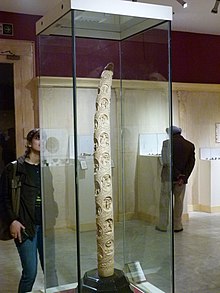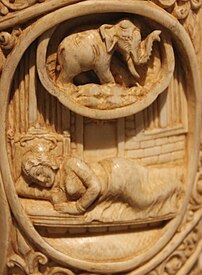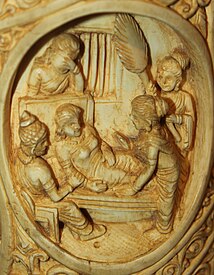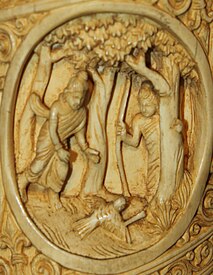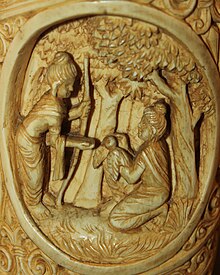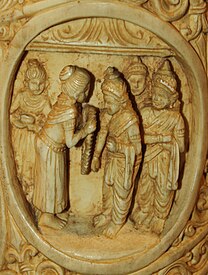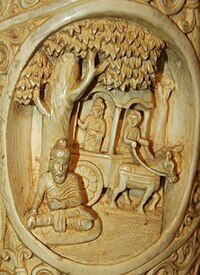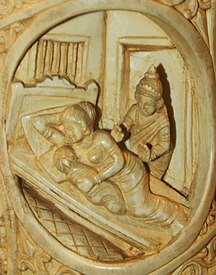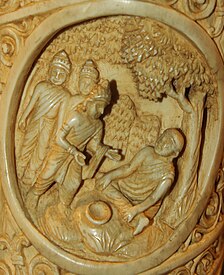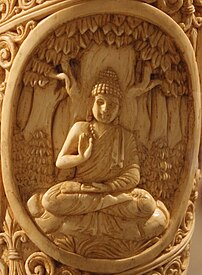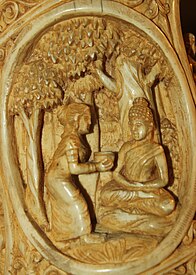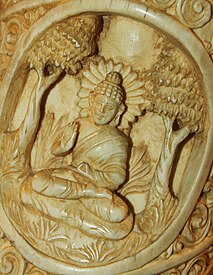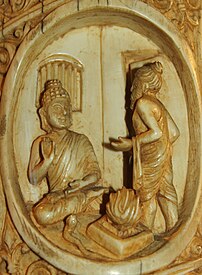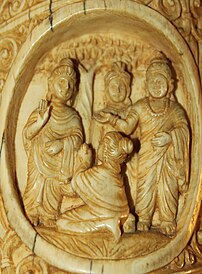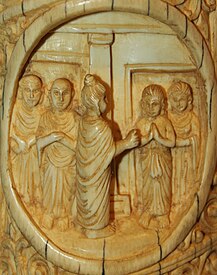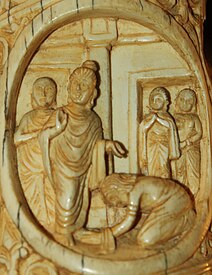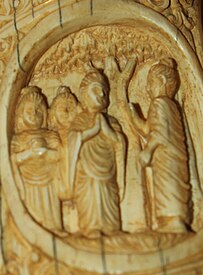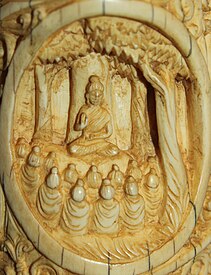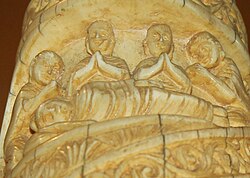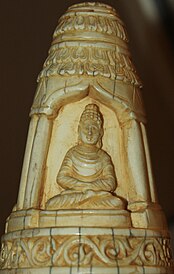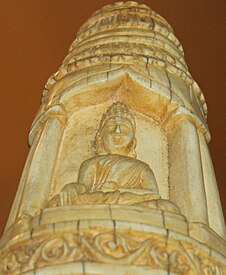
A mudra is a symbolic or ritual gesture or pose in Hinduism, Jainism and Buddhism. While some mudras involve the entire body, most are performed with the hands and fingers.
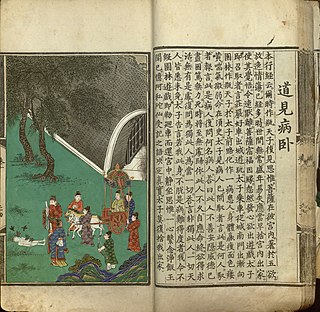
The four sights are four events described in the legendary account of Gautama Buddha's life which led to his realization of the impermanence and the ultimate dissatisfaction of conditioned existence. According to this legend, before these encounters Gautama Siddhartha had been confined to his palace by his father, who feared that he would become an ascetic if he came into contact with sufferings of life according to a prediction. However, his first venture out of the palace affected him deeply and made him realize the sufferings of all, and compelled him to begin his spiritual journey as a wandering ascetic, which eventually led to his enlightenment. The spiritual feeling of urgency experienced by Siddhārtha Gautama is referred to as saṃvega.
Rahul (Pāli) or Rāhula was the only son of Siddhārtha Gautama, commonly known as the Buddha, and his wife, princess Yaśodharā. He is mentioned in numerous Buddhist texts, from the early period onward. Accounts about Rāhula indicate a mutual impact between Prince Siddhārtha's life and the lives of his family members. According to the Pāli tradition, Rāhula was born on the day of Prince Siddhārtha's renunciation, and was therefore named Rāhula, meaning a fetter on the path to enlightenment. According to the Mūlasarvāstivāda tradition, and numerous other later sources, however, Rāhula was only conceived on the day of Prince Siddhartha's renunciation, and was born six years later, when Prince Siddhārtha became enlightened as the Buddha. This long gestation period was explained by bad karma from previous lives of both Yaśodharā and of Rāhula himself, although more naturalistic reasons are also given. As a result of the late birth, Yaśodharā needed to prove that Rāhula was really Prince Siddhārtha's son, which she eventually did successfully by an act of truth. Historian H.W. Schumann has argued that Prince Siddhārtha conceived Rāhula and waited for his birth, to be able to leave the palace with the king and queen's permission, but Orientalist Noël Péri considered it more likely that Rāhula was born after Prince Siddhārtha left his palace.

Dipankara or Dipankara Buddha is one of the Buddhas of the past. He is said to have lived on Earth four asankheyyas and one hundred thousand kappas ago. According to some Buddhist or folk traditions, Dipankara was a previous Buddha who attained Enlightenment eons prior to Gautama Buddha, the historical Buddha.

Śuddhodana, meaning "he who grows pure rice," was the father of Siddhartha Gautama, better known as the Buddha. He was a leader of the Shakya, who lived in an oligarchic republic, with their capital at Kapilavastu.

Maya, also known as Mahāmāyā and Māyādevī, was the queen of Shakya and the birth mother of Gautama Buddha, the sage on whose teachings Buddhism was founded. She was the wife of Śuddhodana, the king of the Shakya kingdom. She was sister of Mahāpajāpatī Gotamī, the first Buddhist nun ordained by the Buddha.

Yaśodharā or Yashodhara was the wife of Prince Siddhartha, the mother of Rāhula, and the sister of Mahaprajapati Gautami. She later became a Bhikkhunī and is considered an arahatā.

According to Buddhist legend, Kanthaka was an eighteen cubit long, favourite white horse and royal servant of Prince Siddhartha, who later became Gautama Buddha. Siddhartha used Kanthaka in all major events described in Buddhist texts prior to his renunciation of the world. Following the departure of Siddhartha, Kanthaka died of a broken heart.
Devdaha is a municipality in Rupandehi District of Nepal, the ancient capital of Koliya Republic, located 7 km east of Lumbini and east of Butwal and shares a border with Nawalparasi district on the east side. It is identified as the maternal home of Queen Mayadevi, Prajapati Gautami and Princess Yasodhara. There are many places to visit in Devdaha. It is believed that Prince Siddhartha had spent some years of his childhood with his step-mother/aunt Prajapati Gautami in Devdaha.
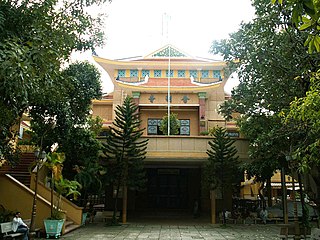
The Xá Lợi Pagoda is the largest pagoda in Hồ Chí Minh City, Vietnam. It was built in 1956 and was the headquarters of Buddhism in South Vietnam. The pagoda is located in District 3, Hồ Chí Minh City and lies on a plot of 5000 square metres. The name Xá Lợi is the Vietnamese translation for śarīra, a term used for relics of Buddhists.

Princess Sundarī Nandā of Shakya, also known simply as Sundarī, was the daughter of King Suddhodana and Queen Mahapajapati Gotami. She was the half-sister of Siddhartha Gautama, who later became a Buddha. She became a nun after the enlightenment of her half-brother and became an arhat. She was the foremost among bhikkhunis in the practice of jhana. She lived during the 6th century BCE in what is now Bihar and Uttar Pradesh in India.
The Buddha was born into a noble family in Lumbini in 563 BCE as per historical events and 624 BCE according to Buddhist tradition. He was called Siddhartha Gautama in his childhood. His father was king Śuddhodana, leader of the Shakya clan in what was the growing state of Kosala, and his mother was queen Maya. According to Buddhist legends, the baby exhibited the marks of a great man. A prophecy indicated that, if the child stayed at home, he was destined to become a world ruler. If the child left home, however, he would become a universal spiritual leader. To make sure the boy would be a great king and world ruler, his father isolated him in his palace and he was raised by his mother's younger sister, Mahapajapati Gotami, after his mother died just seven days after childbirth.

Asita or Kaladevala or Kanhasiri was a hermit ascetic depicted in Buddhist sources as having lived in ancient India. He was a teacher and advisor of Suddhodana, a sage and seer, the father of the Buddha, and is best known for having predicted that prince Siddhartha of Kapilavastu would either become a great chakravartin or become a supreme religious leader; Siddhartha was later known as Gautama Buddha.

The Legend of Buddha is a 2004 Indian English-language animated film directed by Shamboo Falke. The film tells the story of Prince Siddhartha Gautama, who leaves his kingdom to become the spiritual leader, Buddha. The film was submitted for the Academy Award for Best Animated Feature at the 77th Academy Awards but was not nominated.
Buddha — Rajaon Ka Raja is an Indian drama series which aired on Zee TV and DD National, produced by Bhupendra Kumar Modi, under the banner Spice Global. The programme stars Kabir Bedi in a cameo role as Asita Muni, the sage who announces the coming of Gautama Buddha. The story of the serial is based on the life of Gautama Buddha that shows how a prince, Siddhartha, became a Buddha. The role of Mayadevi – scheduled to be played by Sameksha Singh – was replaced with Deepika Upadhyay. Himanshu Soni played the lead role of Buddha, while Kajal Jain played Siddhartha Gautama's wife Yaśodharā. Earlier, Ashutosh Gowariker wanted to collaborate with Shekhar Kapur for a television series on Buddha.
Buddhavanam is a tourism project in Nagarjuna Sagar, Telangana created by the Telangana Tourism Development Corporation. The project was sanctioned by the Government of India viz., Integrated Development of Nagarjunasagar as part of Lower Krishna valley Buddhist circuit with a view to attract large number of domestic and foreign tourists particularly from the South-East Asian countries.

Kapilavastu was an ancient city in the eastern Nepal which was the capital of the clan gaṇasaṅgha or "republic" of the Shakyas in the late Iron Age, around the 6th and 5th centuries BC. King Śuddhodana and Queen Māyā are believed to have lived at Kapilavastu, as did their son Prince Siddartha Gautama until he left the palace at the age of 29.

The Great Renunciation or Great Departure is the traditional term for the departure of Gautama Buddha from his palace at Kapilavastu to live a life as an ascetic. It is called the Great Renunciation because it is regarded as a great sacrifice. Most accounts of this event can be found in post-canonical Buddhist texts from several Buddhist traditions, which are the most complete. These are, however, of a more mythological nature than the early texts. They exist in Pāli, Sanskrit and Chinese language.

The Eight Great Events (aṣṭamahāpratihārya) are a set of episodes in the life of Gautama Buddha that by the time of the Pala Empire of North India around the 9th century had become established as the standard group of narrative scenes to encapsulate the Buddha's life and teachings. As such they were frequently represented in Buddhist art, either individually or as a group, and recounted and interpreted in Buddhist discourses.

Narrative images of episodes from the life of Gautama Buddha in art have been intermittently an important part of Buddhist art, often grouped into cycles, sometimes rather large ones. However, at many times and places, images of the Buddha in art have been very largely single devotional images without narrative content from his life on Earth.
